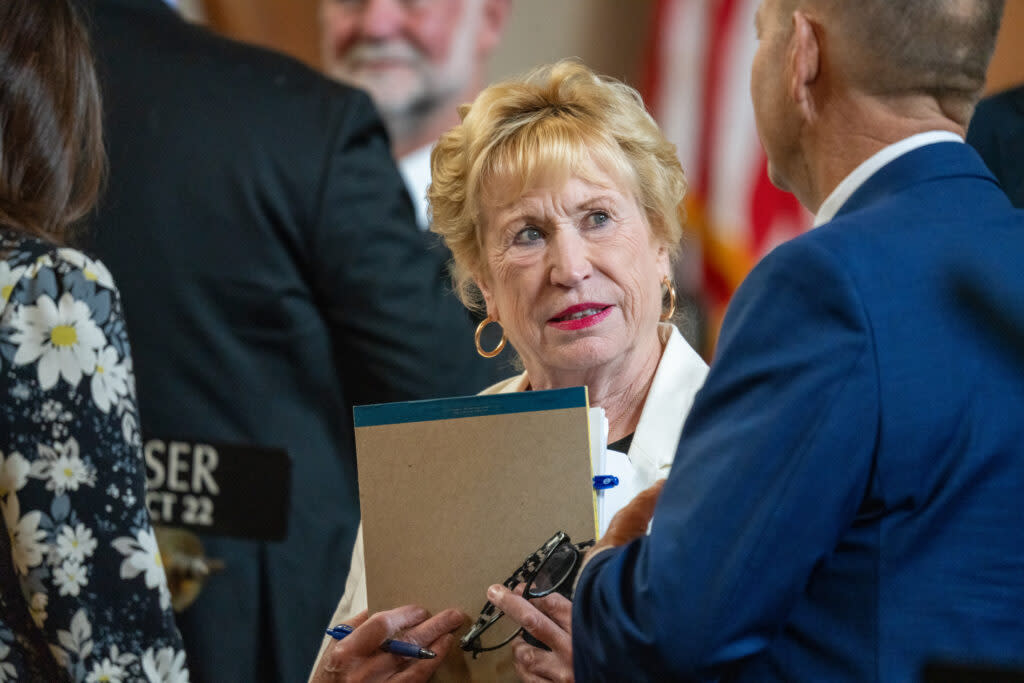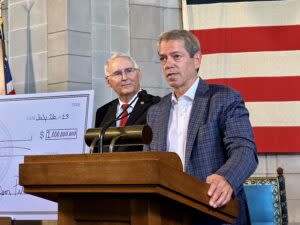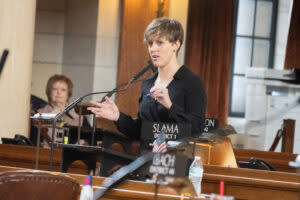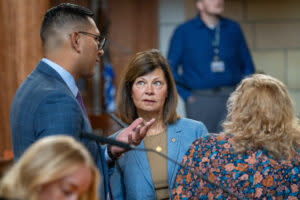Lawmakers introduce Gov. Pillen’s property tax plan, which would require legislation in 2025

- Oops!Something went wrong.Please try again later.
State Sen. Lou Ann Linehan of Elkhorn, Revenue Committee chair, is the lead sponsor of Gov. Jim Pillen's main property tax relief proposal during the Legislature's 2024 special session. July 25, 2024. (Zach Wendling/Nebraska Examiner)
LINCOLN — Gov. Jim Pillen’s property tax proposals were officially introduced Thursday in the Nebraska Legislature, which included a major tax credit program instead of reducing school district tax rates to provide relief.
State Sen. Lou Ann Linehan of Elkhorn, the Legislature’s Revenue Committee chair, introduced Legislative Bill 1 on Thursday on Pillen’s behalf. While the governor and his staff have said the end goal is reducing all local school district general fund levies to 0 by 2027, the final bill took the form of a massive property tax credit program instead of a previously pitched three-part levy reduction.
“The fact that the governor didn’t even put in an education bill shows that perhaps he has no ideas or is unserious about how to go about funding education,” State Sen. Danielle Conrad of Lincoln said. “That point really should be underlined.”
New property tax credits for schools
During the past two months, Pillen has pitched reducing local property taxes by an average of 50%, and Linehan said she remains committed to that goal.
The pitch is to reduce maximum school tax rates to 15 cents in year one and 7.5 cents in year two before the state assumes the total 80% chunk of all local school district property taxes in year three. That’s a sum of more than $2.6 billion.
Schools could still collect property taxes through voter approved bonds or for two building-related funds. And a majority of voters could approve more property tax authority.
But under LB 1, instead of physically placing caps on those general fund tax rates as Pillen and his staff suggested, the state would retool existing property tax relief credit programs and offer a new credit just for school taxes.
The total amount of those credits are as follows:
In tax year 2025: $2.033 billion.
In tax year 2026: $2.354 billion.
In tax year 2027: $2.724 billion.
The Education Future Fund would be retooled to handle the credit program.
Nebraskans would see those credits, at least initially, when they receive their annual property tax statement. Their portion would be equal to the ratio of their property, or properties, to the total property valuations in their respective county. The bill asks future lawmakers to eliminate general fund authority, similar to 2023 legislation for community colleges.
In addition to existing homestead exemptions, which would not change under LB 1, the sum would equate to what Pillen’s office has determined would be the levy reduction.
There would remain nearly $200 million for tax credits for all other political subdivisions.
‘We can’t do it the easy way’
Linehan said relief should be sustainable and come with spending controls. In her eight years in the Legislature, she said, lawmakers passed $1 billion in relief, but “nobody saw it” because of out-of-control spending.
“We can’t do it the easy way,” Linehan said. “We’re going to have to do it the hard way.”
State Sen. Julie Slama said tax credit recycles money back to taxpayers with no real return on investment and no real property tax cuts.
She said LB 1 represents “a pure tax increase” that would pay off for Nebraska’s large landowners, including Pillen, Ted Turner and Bill Gates, “who will be doing gangbusters on this bill.”
“He wants to say that he did something,” Slama said of Pillen. “He wants to give himself a pat on the back so he can fly the banner of ‘Mission Accomplished,’ when in reality everybody’s tax bill is going to be the same.”
Municipal and county governments
Hard caps are proposed on how much more in property taxes municipal and county governments can collect each year. In the spring, the cap was the greater of 3% or the level of inflation.
Under LB 1, local governments could get either flat budgets, in deflationary times, or the percentage increase of the Consumer Price Index for All Urban Consumers for the previous 12-month period at the end of each calendar year.
There would be exceptions for local or state emergencies, growth, new services related to an “imminent and significant threat” to public health or safety and increased compensation to fill vacant law enforcement, firefighting or corrections officer positions
Political subdivisions could carry forward unused property tax request authority, though the increase couldn’t exceed an aggregate of 5% over the prior year’s collection.
A local government could increase the amount of taxes collected if approved by a majority of voters in a regularly scheduled (not special) election.
Funding the proposal
State Sen. Rob Clements of Elmwood, Appropriations Committee chair, is carrying two other bills on behalf of Pillen, LB 2 and LB 3. Those would use the state budget to assist with funding.
‘Sin’ tax increases
Legislative Bill 1, introduced during the first day of Nebraska’s special session on property taxes Thursday, calls for increased ‘sin’ taxes on the following items:
Soft drinks and candy — 5.5 cents per dollar purchase, plus local sales taxes (currently sales tax exempt).
Consumable hemp products — 30% wholesale (currently sales tax exempt).
E-cigarettes, or vapes — 30% wholesale, up from a two-tiered tax that is a 5-cent-per-militer excise tax on disposable vape liquids and a 10% wholesale tax on other electronic nicotine products.
Cigarettes — $1.64 per pack of 20 (up from 64 cents).
Keno (lottery) — 5% of gross proceeds (up from 2%).
Spirits (does not include beer or wine) — $14.50 per gallon (up from $3.75 per gallon).
Games of skill — 20% of net operating revenue for each cash device.
Other funding in LB 1 calls for taxes on all advertising services from companies with a gross ad revenue of more than $1 billion (at 7.5%), various increases to “sin” items and the elimination of more than 100 sales and use tax exemptions on various goods and services.
Nearly all of those new goods or services would be taxed at 5.5 cents per dollar purchase plus any local sales tax, which range from 0.5 to 2 cents. Those include dating services, motor vehicle repair, pet-related grooming or veterinary services, haircuts and legal services.
Consumable hemp products would be taxed at 30% of the wholesale cost, while two categories of goods and services would be taxed at a lower rate.
Agricultural or manufacturing machinery and equipment would be taxed at 2 cents, as would installation repair and maintenance on just manufacturing equipment. Real property maintenance or repair by carpentry contractors or electricians would be taxed at 4 cents.
These items would be exempt from local sales taxes.
According to a member of the governor’s staff, the intent is still to tax machinery and equipment at 4 cents, as previously indicated, but no amendment has yet been filed. That could be significant for rural senators who have been concerned about removing exemptions on certain agricultural items as well as the general funding estimates.
While Pillen’s staff, and his special session proclamation, has proposed the state collecting all local sales taxes on the newly taxed items, LB 1 does not include that language, and no other bill has yet been introduced to do so. Bill introductions will continue Friday and Saturday.
As written, if the Legislature passed LB 1, nearly every provision would take effect the day after the governor signed the bill. That would run counter to a targeted Oct. 1 implementation date that Pillen’s staff and lawmakers have pointed to previously.
Getting relief for Nebraskans
State Sen. Mike Jacobson of North Platte, who joined Linehan as part of a 17-lawmaker task force working with Pillen on his ideas this summer, said increased sales tax revenue would be distributed statewide.
“To suggest that rural Nebraska is getting disproportionately funded I think is a false narrative,” Jacobson said, pointing to past programs and incentives in eastern Nebraska. “To suggest that they’re getting the short end of the stick is very disingenuous.”
A number of goods that the task force had said would remain exempt ended up making it into the bill.
That includes dark fiber, bailing wire, twine, net wrap and catalysts, chemicals or materials used in producing or manufacturing ethanol. Each was included in a list of state laws set to be repealed under LB 1.
State Sen. Teresa Ibach of Sumner said her understanding was they would remain exempt. She declined to comment on the overall bill as she continues to review it, but she said she remains hopeful that something can be done to provide relief.
“I think Nebraskans deserve it,” Ibach said. “I think there’s got to be a path that we can all compromise and make something work out of the special session.”
State Sens. Anna Wishart of Lincoln declined to comment on the bill’s language until she had reviewed it in its entirety.
“What I can say is I am arriving to this session with a solutions-oriented attitude and keeping an open mind to all ideas,” Wishart said in a text.
State Sen. Eliot Bostar of Lincoln, who is part of the Revenue Committee, said he is also reviewing the bill but sees changes that would need to be made to get his support.
“I don’t yet know how many, because I haven’t gone through the whole thing, but in its current drafting, I don’t support how it’s currently written and what it currently contains,” he said. “I think there’s a lot of work to do going forward.”
Ibach and Bostar were part of the 17-member task force, as was State Sen. Merv Riepe of Ralston, who has been more vocal about his concerns.
Riepe said he is “not any more enthusiastic” about the proposals but that relief needs to be provided “in an orderly and proper way.” He said any plan also needs to stimulate the economy because without growth or other job opportunities, the calculus gets more difficult.
“It appears to be more rural versus urban than it needs to be,” Riepe said.
‘Intent’ to increase K-12 funding
One of the final sections of LB 1 expresses “intent” for future Legislatures to “dramatically” increase state funding to schools. The bill calls for replacing general fund tax rates for schools by 2027.
If the state did not provide consistent funding, the intent would be for the Legislature to allow a “backstop” for schools to go back to property taxes for funding.
Slama described intent language as a “joke” that is more like “a wish and a prayer.”
“You could put into it, ‘The Legislature intends to turn the grass blue and the sky green.’ It’s nonbinding,” Slama said. “There’s nothing to it.”
She added that since the “dawn of time,” the Legislature has said it intends to fund K-12 education but has continually shifted the authority to local property taxpayers.
Conrad said rural senators have voiced concern that their constituents might need “to come hat in hand” to the urban-dominated Legislature and “beg to keep their doors open” for school funding. On the flip side, she said, urban senators have been worried about Pillen having more control over school curricula if the state controlled most K-12 funding.
Instead, she said, Pillen is asking lawmakers to commit to one of the most significant state tax increases in history and “then to just take a trust fall together in the future years.”
“That’s going to be a bridge too far for far too many senators,” Conrad said.
Linehan said that neither she nor the governor is married to any plan and that both want to provide relief. She said lawmakers will remain in Lincoln until that happens.
“I think the idea of a special session to address the single biggest concern in Nebraska is fine,” Linehan said. “As long as we have 25 senators willing to be here, we’ll be here. I don’t see us leaving without getting something done.”
Nebraska Examiner Political Reporter Aaron Sanderford contributed to this report.
The post Lawmakers introduce Gov. Pillen’s property tax plan, which would require legislation in 2025 appeared first on Nebraska Examiner.





